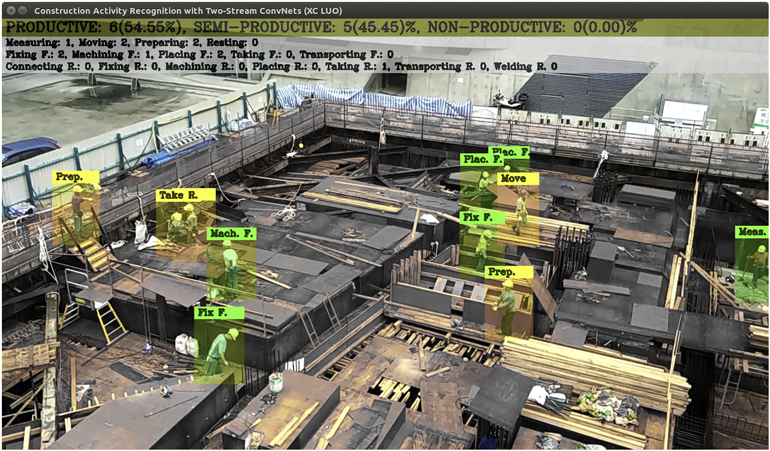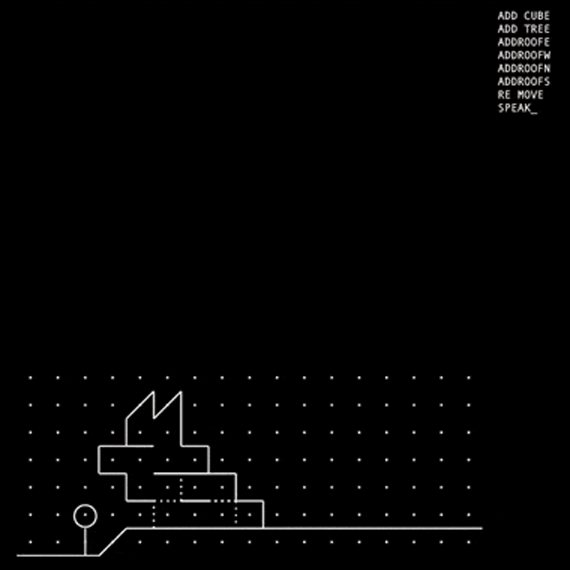Digital Frictions
Examining the points of abrasion in the so-called smart city: where code meets concrete and where algorithms encounter forms of intelligence that aren't artificial.
We are celebrating 15 years — and counting — of stories that are deeply researched and deeply felt, that build a historical record of what the city has been.
As architecture firms experiment with generative design tools, as prospective future inhabitants navigate through simulations of those designed worlds, and as robots and other artificially intelligent agents help to materialize those plans at the construction site, it might seem that computation has fully infused architectural design. For decades, modular architecture, with its patterns and presumed efficiencies, has emblematized these algorithmic aspirations. Yet as Daniel Cardoso Llach argues, modular design and construction are actually where digital abstractions clash with material and social reality. The vexed quest to build the world’s tallest modular tower at Brooklyn’s Atlantic Yards (now Pacific Park, and today the world’s second-tallest) serves as a case in point. Technocratic dreams of seamless interoperability, material efficiency, and frictionless collaboration meet the “unruly worlds of city politics [and] labor, and the gravity of materials.” Those productive frictions ultimately remind us that while architecture might deploy computational tools, it can’t be reduced to computational logics. – SM
Outlining a modular future for American housing, a New York Times article announced in 2012 that real estate developer Bruce Ratner had finally “cracked the code” of prefabricated construction. His company Forest City Ratner’s (FCR) project close to Downtown Brooklyn, likely to cost more than 6 billion dollars in total once finished, included plans to erect the world’s tallest prefabricated building, a 32-story residential tower on the corner of Flatbush Avenue and Dean Street. Combining the latest digital design and building technologies, the tower would not only help the developer fulfill his multiple obligations towards the city — including public space, affordable housing, and construction jobs — but also herald a new era of efficiency in American construction. The tower was part of Brooklyn’s Atlantic Yards (later renamed, unironically, Pacific Park): a gargantuan 22-acre development project initially designed by Frank Gehry. The remarkably contentious and costly process of building the tower — which finally opened in 2016 (most of the renewal project remains under construction) — offers a lesson on the intertwining of design and urban politics with technology. The rhetoric of efficiency that helped animate the building’s design and public perception, metaphorically linking its construction to the making of a software, continues to accompany industry and government efforts to revolutionize building construction through digitally enabled manufacturing, modular construction, and artificial intelligence (AI).
Subdividing work into discrete and carefully regimented chunks, and distributing it along assembly lines, “Taylorist” modes of production in the early 20th century foreshadowed later efforts to digitize manufacturing and construction labor. In line with this logic, Cold-War era proponents of computational design and construction thought of computers and numerically controlled machines as “perfect slaves” or “collaborative partners” of humans, fantasizing with a new kind of labor — absolutely precise and pliant to scientific managerial dictates.[1] Today’s efforts to employ AI and machine learning in construction persist in pursuing these ideals of pliancy and precision, albeit with an updated technical and rhetorical repertoire: systems purporting to automate or augment human labor; to autonomously carry out construction tasks; to surveil and control workers’ bodies and materials’ behavior. Like their Cold-War era predecessors, these approaches overwhelmingly elide the obstinate specificity of designing and building (and perhaps that is their point). But environmental factors, urban politics, and the social and material complexity of buildings make architecture and its construction resistant to technical formalization, let alone automation. After all, buildings are not made in a laboratory, and cities are not made on an assembly line. With this complicated landscape as a background, it may be worth asking: Is a non-Taylorist AI possible, or even desirable?
In its ambition to increase control over construction, FCR’s effort to build the “world’s tallest” modular tower offers a point of reference for present-day efforts towards construction automation, and a glimpse of the tensions that can result from the entanglement of computational and architectural modes of designing and thinking. Modular design and construction are where the rubber of computational abstraction — and the ideals of efficiency, variability, participation, and democracy it often inscribes — meets the road of city politics, messy materials, interoperability setbacks, community organizing, and construction labor. The ensuing frictions tell us something about how contemporary cities are imagined and built, and how we may go about shaping their future.
Plans for Atlantic Yards were unveiled in 2003, amid enthusiastic media coverage and statements of support from public officials, as a joint venture between FCR and the Empire State Development Corporation (ESD), an umbrella organization for the administrations of New York State’s large-scale urban development projects.[2] The existing site included a railyard for the Long Island Railroad as well as residential, manufacturing, and retail buildings. A cornerstone of the project was a basketball arena which, following a few iterations and false starts, would eventually become Barclays Center, designed by AECOM and the New York firm SHoP Architects and opened in 2012.
Opposition to the project was fierce from the beginning. Critics such as the neighborhood-based organization Develop Don’t Destroy Brooklyn (DDDB) pointed to the lack of community involvement in the project’s development, and to the failure of public officials at the municipal and state levels to create the conditions for adequate transparency and oversight.[3] Beyond calling attention to the millions of dollars in public subsidies to the developer, opponents challenged the city’s controversial decision to declare many of the extant buildings blighted, and the subsequent use of eminent domain, a powerful policy muscle, to force owners to sell and leave their properties. Highlighting how, instead of providing oversight, government officials acted as facilitators (and in some cases as cheerleaders) for the developer’s vision, they questioned the close partnership between private and public actors which imparted an aura of inevitability to the project and put millions of dollars in public subsidies in support of a private-led effort. Furthermore, they saw the potential impacts of the project on this area of Brooklyn as an echo of the injustices of 1960s and 1970s urban renewal projects.
Meanwhile, advocates defended the project on the basis of its purported fiscal benefits, the thousands of jobs its construction would generate, and the thousands of low and middle-income housing units it would produce.[4] Alongside public officials — including New York City Mayor Michael Bloomberg, Senator Charles Schumer, and Brooklyn Borough President Martin Markowitz — representatives of New York’s construction unions saw a potential source of well-paid jobs for their members. For Building and Construction Trades Council of Greater New York president Gary La Barbera, the project simply “could be of great consequence to the building trades.”
In 2011, with Barclays Center nearing completion, Ratner unveiled another key component of his vision: a residential tower abutting the arena’s southern end. Central to the narrative surrounding this building was its technological innovation. A Lego structure of sorts, the tower would comprise more than 900 modules fabricated under controlled conditions in an off-site factory and transported to the site on trucks. The developer hired SHoP Architects and the renowned engineering firm Arup to design the tower and the details of its modular system, ensuring that the most advanced digital methods for modeling, analysis, simulation, and manufacturing would assist the resolution of one of architecture’s longtime obsessions. Press coverage of the modular tower touted that the novel method would cut costs in half. Meanwhile, prominent architectural voices joined in with excitement, reflecting the discipline’s longstanding modular romance.
For architects and builders, part of the appeal of modular construction lies in its promise to help manage the remarkably complex process of putting a building together. Transferring work from the construction site to a factory’s more controlled environment follows the Taylorist imperative to compartmentalize and regiment labor, bringing the efficiency of the assembly line to the unruly worlds of building. Working in tandem at both the site and the factory represents additional gains. Roger Krulak, a modular construction entrepreneur involved in the development of Atlantic Yards, describes this method using another computational metaphor: To build modularly is to “parallel process” construction. The increased managerial control over a smaller workforce, lower wages, and the possibility of working on two fronts are powerful incentives for developers to transfer as much work as possible from the site to the factory.
Despite the enthusiastic voices in popular and trade media, not everyone was happy about the new approach. Representatives of unions in the building trades — whose support had been key during the project’s early stages — were quick to note that modularized construction would reduce the need for workers by transferring the effort away to a factory, where labor is significantly cheaper. A union worker making $85 an hour in wages and benefits working on site, they realized, would make only $35 working in a factory. In spite of this, unions ultimately supported the project. The factory job guaranteed steady hours regardless of the outside weather, and offered workers a foothold in the new and promising field of modular construction. For the developer, building modularly meant lowering costs by cutting wages and by increasing managerial control, which it presented as a revolutionary shift in the construction industry. “With modular,” Ratner explained at the time, “we are also transforming how housing is built in New York City and, potentially, around the world.”
Promises of precision, new jobs, and speed notwithstanding, the project went through long delays, construction problems, legal challenges, and massive budget overruns. Only 100 new jobs were reportedly created. Skanska, the Swedish construction giant FCR partnered with to operate the Brooklyn Navy Yard factory producing the modules, shut down production there in 2014, blaming the developer for what they described as flawed designs. A Skanska executive remarked bluntly that the project “was represented to be a complete and buildable modular design [but] that simply was not the case and that’s what we’ve been struggling with.” With FCR and Skanska embroiled in a bitter legal dispute, and with the effects of the global economic recession in the background, the benefits of digitally-enabled modular design and construction seemed in doubt. Additional reports of structural problems, water damage in multiple units, and other issues further challenged modular construction as the future of construction in the US. Some of the architects on the team were also aware of the important drawbacks of modularity. For example, they understood that making a building by aggregating discrete, structurally independent units significantly increases a building’s overall weight and, consequentially, the use of expensive structural materials such as steel. The taller the building, the more acute this problem becomes. As SHoP Architects’ John Cerone stated simply in a 2015 interview: “you are doubling up on everything.”
Following a series of construction problems, delays, and cost overruns, FCR took over the construction and the tower was finally completed in 2016. Responding to press queries about this tortuous process, FCR CEO MaryAnne Gilmartin offered yet another computational metaphor wrapped in familiar innovation-speak: “The good news is that we’ve worked out a lot of the bugs and gotten through the growing pains of innovation” (emphasis mine). Despite this declaration of success, FCR exited the business of modular construction almost immediately after the project’s completion.
In the construction of the modular tower at Atlantic Yards, computation operated ambivalently at different registers. Computational idioms were used to represent the building as a piece of software — its design as a “code to be cracked,” its construction is to be “parallel processed,” its logistical hurdles to be “debugged.” These idioms help cast the cumbersome process of building in the more sanitized language of software development, endowing construction with an aura of weightlessness, and hiding the messier aspects of its production from public view.
Yet, in this project, computation was not merely a metaphor, but also a series of specific methods for building simulation and fabrication. Over the last 40 years, computers’ increased processing power and display capacities, and industry’s need for greater detail in building documentation, have pushed computer-aided design (CAD) systems in the direction of data-rich building representations that capture not only geometric but also material, functional, and logistic aspects of buildings in highly detailed 3D models — sometimes called Building Information Models, or BIMs. The economic benefits of modular construction are often tied to the increased precision enabled by these models. For example, Christopher Sharples, a principal architect at SHoP, stated in 2012 that “[t]he solution to producing high-rise modular buildings came, in part, from the ability to create computerized three-dimensional models that allowed them to test the integrity of the engineering.” This view illustrates a common aspiration in architectural and building industry circles to place software and simulation at the center of the building design and construction process: a sort of lingua franca enabling seamless communication and collaboration across different trades — architects, engineers, contractors, developers, and clients.
In addition, modularity is “digital” not simply because it is enabled by software and numerically controlled machines, or because it can be wrapped in techno-speak, but because it seeks to manage the complexity of design and construction through quintessentially computational methods: abstraction (to generalize and codify) and encapsulation (to black box). In architecture, as in software, modules are repeatable and exchangeable. Once resolved, or codified, the details of their internal operation can be taken for granted — “black boxed” — to be interchangeably arranged in complex compositions. Transferring construction work from a building’s construction site into the more controlled environments of modular factories, the story goes, helps reduce the risk of error while cutting timelines and labor costs. However, the story of the modular tower at Atlantic Yards suggests that by attempting to codify and black-box messy aspects of building, those imagining architecture as a software can also lose sight of crucial material and sociotechnical frictions.
Ratner’s ambition to revolutionize housing through computerized modular design and construction was not new. Throughout the 20th century, factory-built modular housing projects encoded distinctly modern aspirations to reconcile industrial materials and methods of production with social and urban visions. Le Corbusier’s Modulor and his famous articulation of the house as a “machine for living,” for example, hint at this sensibility, while iconic projects such as Moshe Safdie’s 1967 Habitat and Kisho Kurokawa’s 1972 Nakagin Capsule Tower give it concrete expression. When the computer crept into the frame of architecture, it helped amplify these ambitions. Techno-utopian architects and experimentalists such as Nicholas Negroponte and Yona Friedman, for example, used the computer as a canvas on which to render visions of modular and participatory architecture and urbanism. In combination with computational methods and concepts, modularity offered these architects a language that seemed to bridge technical rationality and the possibility of satisfying the needs of individual dwellers, now imagined as “users.” Their experimental CAD systems codified visions of computers as emancipatory tools giving people the power to design “their own” environments, bypassing architects and planners.[5] Modularity conveniently linked the elemental vocabularies of contemporary software and hardware with those of mass-produced industrial construction materials. Furthermore, software’s interactive capacities seemed well suited to express ideals of democratic participation — ideals that could be imagined in opposition to the authoritarian politics enacted by other, more monolithic, architectures.
These architectural lineages notwithstanding, the concept of modularity can be traced to earlier, perhaps less glamorous, attempts to universalize standards for building components. In the 1930s, for example, American civil engineer Albert Farwell Bemis worked to base all US housing construction on a four-inch module, helping delineate the concept of modularity as we understand it today.[6] Using Bemis as an example, historian Andrew Russell rightly observes that architectural notions of modularity precede computational ones. And yet, the practices and discourses surrounding the construction of the modular tower at Atlantic Yards (now the world’s second-tallest), with their constant interplay between architectural and computational idioms, show us that the opposite trajectory is also at play, and that concepts of computing and software crucially inform the architectural imagination. Ever since the emergence of digital computers, architecture and software have been entangled in a game of reversible metaphors. The rhetoric resulting from this exchange, while at times generative and almost always useful as a proselytizing tool, is remarkably slippery, and has a history of helping obscure what is indeed particular about each domain. Claims of building efficiency, economy, or democratization aside, these transfers are never innocent. What we see is a friction between the clean worlds of digital abstraction and the unruly worlds of city politics, labor, and the gravity of materials; between the rhetoric of technological seamlessness collapsing design and construction for cost and time efficiencies, and the seamful, contested realities of their implementation amidst a flurry of political, material, and spatial contingencies. A building, after all, is not a software.
This argument is developed in more detail in Daniel Cardoso Llach, Builders of the Vision: Software and the Imagination of Design (New York: Routledge, 2015).
Amy Lavine and Norman Oder, “Urban Redevelopment Policy, Judicial Deference to Unaccountable Agencies, and Reality in Brooklyn’s Atlantic Yards Project,” The Urban Lawyer 42, no. 2 (2010): 287–373.
DDDB’s strong opposition to the Atlantic Yards development is documented in “Battle for Brooklyn,” directed by Michael Galinsky and Suki Hawley (RUMUR, 2011).
More than 15 years after the project was announced, most of these benefits are yet to materialize. For a close and frequently updated look at this project see Atlantic Yards Report
See Nicholas Negroponte, The Architecture Machine: Toward a More Human Environment (Massachusetts: The MIT Press, 1973). Yona Friedman, Toward a Scientific Architecture, trans. Cynthia Lang (Massachusetts: The MIT Press, 1980).
Andrew L. Russell, “Modularity: An Interdisciplinary History of an Ordering Concept,” Information & Culture 47, no. 3 (August 1, 2012): 257–87, https://doi.org/10.7560/IC47301.
The views expressed here are those of the authors only and do not reflect the position of The Architectural League of New York.
Examining the points of abrasion in the so-called smart city: where code meets concrete and where algorithms encounter forms of intelligence that aren't artificial.







